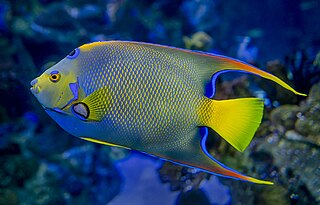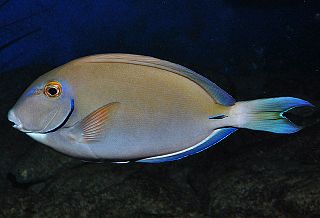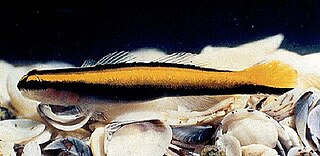
Marine angelfish are perciform fish of the family Pomacanthidae. They are found on shallow reefs in the tropical Atlantic, Indian, and mostly western Pacific Oceans. The family contains seven genera and about 86 species. They should not be confused with the freshwater angelfish, tropical cichlids of the Amazon Basin.

The sergeant major or píntano is a species of damselfish. It grows to a maximum length of about 22.9 centimetres (9.0 in).

The cherubfish, also known as the pygmy angelfish, is a species of marine ray-finned fish, a marine angelfish belonging to the family Pomacanthidae. It is found in the western Atlantic Ocean.

The reef butterflyfish. also known as the least butterflyfish, Atlantic butterflyfish, butterbun or school mistress, is a species of marine ray-finned fish, a butterflyfish of the family Chaetodontidae. It is found in the western Atlantic Ocean.

The Caesar grunt, also known as the black grunt, blacktail grunt, or redmouth grunt is a species of marine ray-finned fish, a grunt in the family Haemulidae. It is native to the western Atlantic Ocean

The French angelfish is a species of marine ray-finned fish, a marine angelfish belonging to the family Pomacanthidae. It occurs in the Western Atlantic Ocean.

The gray angelfish, also written as grey angelfish and known in Jamaica as the pot cover, is a species of marine ray-finned fish belonging to the marine angelfish family, Pomacanthidae. It is found in the Western Atlantic Ocean.

Cleaner fish are fish that show a specialist feeding strategy by providing a service to other species, referred to as clients, by removing dead skin, ectoparasites, and infected tissue from the surface or gill chambers. This example of cleaning symbiosis represents mutualism and cooperation behaviour, an ecological interaction that benefits both parties involved. However, the cleaner fish may consume mucus or tissue, thus creating a form of parasitism called cheating. The client animals are typically fish of a different species, but can also be aquatic reptiles, mammals, or octopuses. A wide variety of fish including wrasse, cichlids, catfish, pipefish, lumpsuckers, and gobies display cleaning behaviors across the globe in fresh, brackish, and marine waters but specifically concentrated in the tropics due to high parasite density. Similar behaviour is found in other groups of animals, such as cleaner shrimps.

The queen angelfish, also known as the blue angelfish, golden angelfish, or yellow angelfish, is a species of marine angelfish found in the western Atlantic Ocean. It is a benthic warm-water species that lives in coral reefs. It is recognized by its blue and yellow coloration and a distinctive spot or "crown" on its forehead. This crown distinguishes it from the closely related and similar-looking Bermuda blue angelfish, with which it overlaps in range and can interbreed.

Elacatinus is a genus of small marine gobies, often known collectively as the neon gobies. Although only one species, E. oceanops, is technically the "neon goby", because of their similar appearance, other members of the genus are generally labeled neon gobies, as well. Except for a single East Pacific species, all reside in warmer parts of the West Atlantic, including the Caribbean and Gulf of Mexico. They are known for engaging in symbiosis with other marine creatures by providing them cleaning service that consists of getting rid of ectoparasites on their bodies. In return, Elacatinus species obtain their primary source of food, ectoparasites.

Elacatinus puncticulatus is a species of goby from the eastern central Pacific Ocean, where it is found on reefs from the Gulf of California to Ecuador. This species occurs at depths ranging from 1 to 21m, and usually in association with the sea urchin Eucidaris thouarsii. The size of the goby varies depending on sex, with females being typically smaller than males, and their geographical location as well as their role as a cleaner goby also has impacts on their morphology. Due to their bright coloration and lack of aggression, the species is commonly found in the aquarium trade.

Haemulon vittatum, the boga, is an ocean-going species of grunt native to the western Atlantic Ocean. Bogas are also known as the snit in Jamaica, and bonnetmouth in the Bahamas. It was first described by Cuban zoologist Felipe Poey. This species used to be classified as Inermia vittata, but genetic data revealed that it belongs to the genus Haemulon.
Emmelichthyops atlanticus, the bonnetmouth, is a marine fish species of grunt native to the western Atlantic Ocean, where it occurs from Florida and the Bahamas to northern South America. This species is the only known member of its genus.

Haemulon flavolineatum, the French grunt, banana grunt, gold laced grunt, open-mouthed grunt, redmouth grunt, or yellow grunt, is a species of marine ray-finned fish, a grunt belonging to the family Haemulidae. It is native to the western Atlantic Ocean.

Acanthurus tractus, the five-band surgeonfish, ocean surgeon, or ocean surgeonfish, is a species of ray-finned fish in the family Acanthuridae found in the western Atlantic Ocean, Florida, the Bahamas, the Caribbean Sea and the Gulf of Mexico. Until recently, it was considered a synonym of Acanthurus bahianus, but its status as a separate species was resurrected in 2011.
Elacatinus horsti, the yellowline goby, is a species of goby native to the western Atlantic Ocean and the Caribbean Sea.
Elacatinus chancei, the shortstripe goby, is a species of ray-finned fish in the family Gobiidae. It lives inside or on the surface of a sponge and occurs in tropical waters in the west central Atlantic Ocean, the Bahamas, the Antilles, and Venezuela.

Elacatinus figaro, the barber goby or yellow line goby, is a colourful species of marine goby, family Gobiidae, from the southwestern Atlantic, where it is endemic to the coastal waters of Brazil.
Elacatinus colini, the Belize sponge goby, is a species of goby native to the Western Central Atlantic Ocean, near Belize and Honduras.

Goby is a common name for many species of small to medium sized ray-finned fish, normally with large heads and tapered bodies, which are found in marine, brackish and freshwater environments.
















